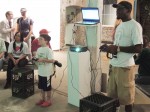With their rapidly put-together parts, exposed wiring and unconventional materials, the games featured at the Punk Arcade will convey much more than mere entertainment.
The Punk Arcadeis a one-day exhibition that will bring together the punk-inspired video game artwork of award-winning designers, writers and UCLA students this Saturday at the Broad Art Center.The exhibition, sponsored by the UCLA Game Lab, will be open to the public from 6 to 9 p.m., and will feature artwork that intertwines the medium of games with the culture of punk.
The exhibition spacewill showcase pieces ranging from interactive toys to completed video games. Using materials like duct tape, spray-paint and cardboard, participants will create a makeshift arcade environment that will allow the public to play and interact with their artwork.
The exhibition space, as well as the games featured, will be designed and assembled by the artists themselves all during a time-sensitive three-day workshop, which started on Nov. 7. The workshop will run until the opening of the exhibition. Open to public participation, it will take place at the UCLA Game Lab and will also be hosted by co-curators Sarah Brin and Lee Tusman.
“We will work with participants to create an entire exhibit in three days … with people writing and designing actual games,” Brin said. “Some of the work will be projected, some of the work will be displayed in custom arcade cabinets, some of the students may come up with other creative ideas on how they want to exhibit their work.”
The workshop kicks off by revealing a punk-focused prompt to the participants to inspire their creations. The participants then have the option to break into teams or work alone to come up with an overall concept to be completed and displayed in time for the exhibition on Saturday.
With the decision to open up the creation of games to the public, Brin believes the workshop could serve as a place where artists feel comfortable expressing their ideas.
“We want people to get away from this analysis paralysis of actualizing their ideas,” Brin said. “Skills shouldn’t be a barrier for entry … it’s important that more than just game designers come.”
And although there are no constraints on who can enter, there are constraints on the amount of time given to work, causing the final products of the exhibition to have a grittier appearance, with the intention to relate to the origins of the do-it-yourself punk look. However, no matter what the final products end up looking like, the Punk Arcade will place emphasis on content over aesthetics, Brin said.
One possible piece that the curators are considering showing in the exhibition is an already-completed game designed by UCLA alumnus Chris Reilly, entitled “Talk Therapy.” The game is presented in a wooden container called an arcade cabinet, decorated with vibrant geometric print and featuring exposed parts, such as an entanglement of wires. The game allows two players to attach a micro-controller to their necks and race each other’s game pieces by controlling the volume of their screams.
“It’s the idea of alternative mechanics, battling against traditional mechanics or traditional ways to play video games … additionally it’s kind of an allusion to punk music, with the actual act of screaming,” Brin said.
Simon Wiscombe, a prospective artist at the Punk Arcade as well as UCLA alumnus and current researcher for game design at USC,is considering design techniques that could give his submission a “hacky” appearance, with exposed hardware.
“I could use anything from a screen to LEDs in a box … I might repurpose a Wii remote or hook up a bunch of circuit vending,” Wiscombe said.
The curators of the event said the video game industry of the past has almost solely featured the perspectives coming from white males, educated in technical fields associated with the industry. By embracing the more inclusive ideology of punk, Brin said she aims to disregard these old barriers, in hopes that it will lead to different voices being heard, possibly with the inclusion of female, queer and other non-traditional protagonists.
“With this event you don’t have to pass through as many filters in order to express yourself in a particular way, you don’t have to pass through the kind of social-economic filter of getting a computer science degree,” Brin said. “You don’t have to pass through the various gender and class-related filters in order to work at a major video game company.”
And just as the curators of the event encourage the creation of works fitting outside the mainstream, they also hope that their exhibition will attract those equally interested in the non-conformist spirit of the event.
“I think this exhibition is for people interested in video games, interested in seeing new ways of creating games,” Tusman said. “And (people) interested in seeing something new and different.”
Email Gill at ngill@media.ucla.edu.

Thanks for the coverage! Was this article written with speech to text? I love all the fun robo-spelling!